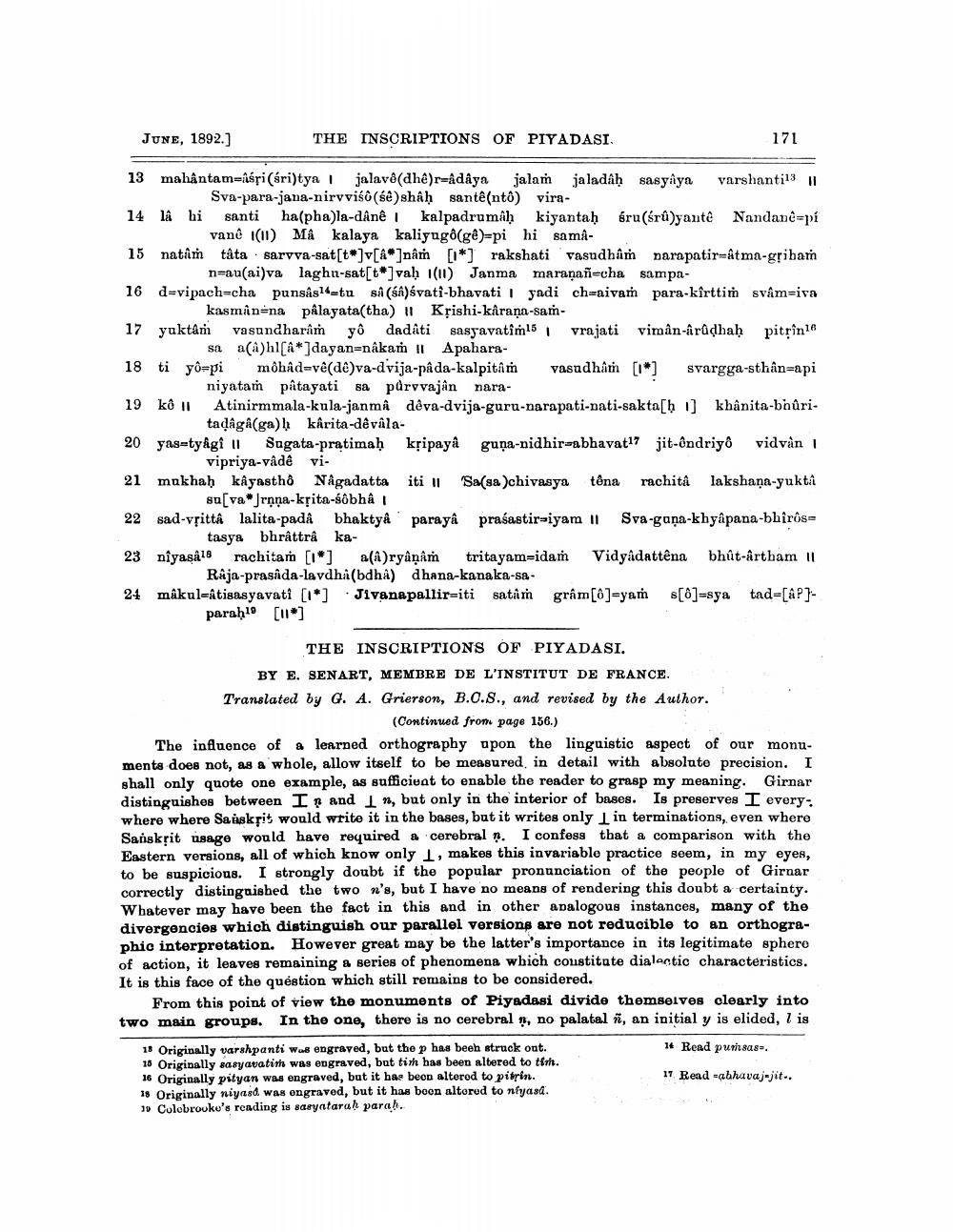________________
JUNE, 1892.]
THE INSCRIPTIONS OF PIYADASI.
171
13 mahậntam=isri (ári)tya jalavê (dhe)r=adâya jalan jaladah sasyaya varshanti13 11
Sva-para-jana-nirvviso (se) shah santé(nto) vira14 la hi santi ha(pha)la-danêkalpadrumah kiyantaḥ śru(sr)yante Nandane=pí
vané (11) Må kalaya kaliyugô(ge)-pi hi sama15 natam tata . sarvva-sat[t]v[A*]nâm [*) rakshati vasudham parapatir-Atma-gribam
n=au(ai)va laghu-sat[t*]vah 1(11) Janma maraņañ=cha sampa16 d=vipach=cha punsås14-tu så (sa)śvati-bhavati Iyadi ch=aivan para-kîrttim svâm=iva
kasmin=na pålagata(tha) 11 Krishi-karaṇa-sam17 yaktar vasundharam yo dadati saskavatîm15 vrajati vimin-îrûdhah pitrinle
sa a()h1[A*]dayan=nâkam | Apahara18 ti yô=pi môhâd=vê(dê)va-dvija-pâda-kalpitîm vasudhâm [10] svargga-sthân=api
niyatam pâtayati sa purvvajan nara19 kê !! Atinirmmala-kula-janma dêva-dvija-guru-narapati-nati-sakta[h 1] khânita-bhůri
tadâgâ(ga) kârita-dêvala20 yasetyagi 11 Sagata-pratimaḥ kripaya guņa-nidhir-abhavat17 jit-ôndriyô vidvận 1
vipriya-vâdê vi21 makhaḥ kåyasthô Någadatta iti 11 Sa(sa)chivasya têna rachita lakshana-yukta
so[va*Jrņņa-ksita-sôbhê! 22 sad-vșitta lalita-pada bhakty&' paraya praśastir-iyam 11 Sva-gana-khyapana-bhirosa
tasya bhrâttra ka23 niyasals rachita [1*] a(A)ryaņâm tritayam-idam Vidyâdattêna bhût-artham 11
Raja-prasada-lavdha(bdha) dhana-kanaka-sa24 mäkul=htisasyavati [l*] Jivanapallir=iti satim grâm[]=yam s[8]=sya tad-[AP]
paraḥ19 [11*]
THE INSCRIPTIONS OF PIYADASI. BY E. SENART, MEMBRE DE L'INSTITUT DE FRANCE. Translated by G. A. Grierson, B.O.S., and revised by the Author.
(Continued from page 156.) The influence of a learned orthography apon the linguistic aspect of our monuments does not, as a whole, allow itself to be measured in detail with absolute precision. I shall only quote one example, as sufficiuat to enable the reader to grasp my meaning. Girnar distinguishes between I and I n, but only in the interior of bases. Is preserves I every: where where Sanskrit would write it in the bases, but it writes only 1 in terminations, even where Sanskrit usage would have required a cerebral 1. I confess that a comparison with the Eastern versions, all of which know only 1, makes this invariable practice seem, in my eyes, to be suspicious. I strongly doubt if the popular pronunciation of the people of Girnar correctly distinguished the two n's, but I have no means of rendering this doubt a certainty. Whatever may have been the fact in this and in other analogous instances, many of the divergencies which distinguish our parallel versions are not reducible to an orthographic interpretation. However great may be the latter's importance in its legitimate sphere of action, it leaves remaining a series of phenomena which coustitute dialectic characteristics. It is this face of the question which still remains to be considered.
From this point of view the monuments of Piyadasi divide themselves clearly into two main groups. In the one, there is no cerebral , no palatal i, an initial y is elided, I is
14 Read punsas.
18 Originally varshpanti was engraved, but the p has been struck out. 16 Originally easyavatish was engraved, but tich has been altered to tim. 16 Originally pityan was engraved, but it ha. beon alterod to pitrin. 18 Originally niyasd was ongraved, but it has boon altered to niyasd. 3Colobrouku's reading is easyatarah parah.
17 Read -abhavaj-jit..




